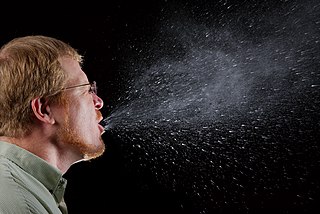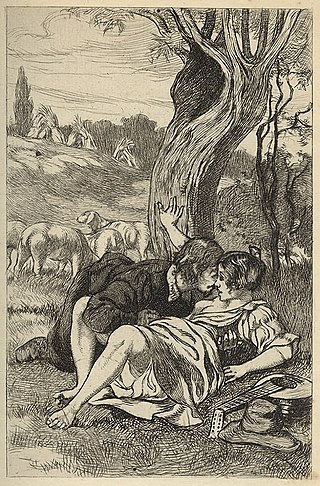Related Research Articles

Orgasm, or sexual climax, is the sudden discharge of accumulated sexual excitement during the sexual response cycle, resulting in rhythmic, involuntary muscular contractions in the pelvic region characterized by sexual pleasure. Experienced by males and females, orgasms are controlled by the involuntary or autonomic nervous system. They are usually associated with involuntary actions, including muscular spasms in multiple areas of the body, a general euphoric sensation, and, frequently, body movements and vocalizations. The period after orgasm is typically a relaxing experience, attributed to the release of the neurohormones oxytocin and prolactin as well as endorphins.

The autonomic nervous system (ANS), formerly referred to as the vegetative nervous system, is a division of the nervous system that supplies internal organs, smooth muscle and glands. The autonomic nervous system is a control system that acts largely unconsciously and regulates bodily functions, such as the heart rate, its force of contraction, digestion, respiratory rate, pupillary response, urination, and sexual arousal. This system is the primary mechanism in control of the fight-or-flight response.

A sneeze is a semi-autonomous, convulsive expulsion of air from the lungs through the nose and mouth, usually caused by foreign particles irritating the nasal mucosa. A sneeze expels air forcibly from the mouth and nose in an explosive, spasmodic involuntary action. This action allows for mucus to escape through the nasal cavity. Sneezing is possibly linked to sudden exposure to bright light, sudden change (drop) in temperature, breeze of cold air, a particularly full stomach, exposure to allergens, or viral infection. Because sneezes can spread disease through infectious aerosol droplets, it is recommended to cover one's mouth and nose with the forearm, the inside of the elbow, a tissue or a handkerchief while sneezing. In addition to covering the mouth, looking down is also recommended in order to change the direction of the droplets spread and avoid high concentration in the human breathing heights.
Medical fetishism refers to several sexual fetishes in which participants derive sexual pleasure from medical scenarios including objects, practices, environments, and situations of a medical or clinical nature. In sexual roleplay, a hospital or medical scene involves the sex partners assuming the roles of doctors, nurses, surgeons and patients to act out specific or general medical fetishes. Medical fantasy is a genre in pornography, though the fantasy may not necessarily involve pornography or sexual activity.
Anorgasmia is a type of sexual dysfunction in which a person cannot achieve orgasm despite adequate stimulation. Anorgasmia is far more common in females than in males and is especially rare in younger men. The problem is greater in women who are post-menopausal. In males, it is most closely associated with delayed ejaculation. Anorgasmia can often cause sexual frustration.

Sexual stimulation is any stimulus that leads to, enhances and maintains sexual arousal, and may lead to orgasm. Although sexual arousal may arise without physical stimulation, achieving orgasm usually requires it.
Persistent genital arousal disorder (PGAD), previously called persistent sexual arousal syndrome, is spontaneous, persistent, unwanted and uncontrollable genital arousal in the absence of sexual stimulation or sexual desire, and is typically not relieved by orgasm. Instead, multiple orgasms over hours or days may be required for relief.
Sexual dysfunction is difficulty experienced by an individual or partners during any stage of normal sexual activity, including physical pleasure, desire, preference, arousal, or orgasm. The World Health Organization defines sexual dysfunction as a "person's inability to participate in a sexual relationship as they would wish". This definition is broad and is subject to many interpretations. A diagnosis of sexual dysfunction under the DSM-5 requires a person to feel extreme distress and interpersonal strain for a minimum of six months. Sexual dysfunction can have a profound impact on an individual's perceived quality of sexual life. The term sexual disorder may not only refer to physical sexual dysfunction, but to paraphilias as well; this is sometimes termed disorder of sexual preference.

Flushing is to become markedly red in the face and often other areas of the skin, from various physiological conditions. Flushing is generally distinguished from blushing, since blushing is psychological, milder, generally restricted to the face, cheeks or ears, and generally assumed to reflect emotional stress, such as embarrassment, anger, or romantic stimulation. Flushing is also a cardinal symptom of carcinoid syndrome—the syndrome that results from hormones being secreted into systemic circulation.
Edging, peaking, or surfing is a sexual technique whereby an orgasm is controlled. It is practiced alone or with a partner and involves the maintenance of a high level of sexual arousal for an extended period without reaching climax.

Erotic talk, also known as dirty talk, gross talk, love talk, naughty talk, sexting, sexy talk, talking dirty, or talking gross is the practice of using explicit word imagery to heighten sexual excitement before and during physical sexual activity. It is commonly a part of foreplay, and can include vivid erotic descriptions, sexual humor, sexual commands and rude words. It may be whispered into a partner's ear, spoken over a telephone, or put into text. The intention of erotic talk is generally to generate excitement between one, both or all parties engaged in a sexual interaction, or even to induce orgasm.

The photic sneeze reflex is an inherited and congenital autosomal dominant reflex condition that causes sneezing in response to numerous stimuli, such as looking at bright lights or periocular injection. The condition affects 18–35% of the world's population, but its exact mechanism of action is not well understood.
Delayed ejaculation (DE) describes a man's inability or persistent difficulty in achieving orgasm, despite typical sexual desire and sexual stimulation. Generally, a man can reach orgasm within a few minutes of active thrusting during sexual intercourse, whereas a man with delayed ejaculation either does not have orgasms at all or cannot have an orgasm until after prolonged intercourse which might last for 30–45 minutes or more. Delayed ejaculation is closely related to anorgasmia.

Human female sexuality encompasses a broad range of behaviors and processes, including female sexual identity and sexual behavior, the physiological, psychological, social, cultural, political, and spiritual or religious aspects of sexual activity. Various aspects and dimensions of female sexuality, as a part of human sexuality, have also been addressed by principles of ethics, morality, and theology. In almost any historical era and culture, the arts, including literary and visual arts, as well as popular culture, present a substantial portion of a given society's views on human sexuality, which includes both implicit (covert) and explicit (overt) aspects and manifestations of feminine sexuality and behavior.
Honeymoon rhinitis is a condition in which the sufferer experiences nasal congestion during sexual intercourse or arousal.
Postorgasmic illness syndrome (POIS) is a syndrome in which people have chronic physical and cognitive symptoms following ejaculation. The symptoms usually onset within seconds, minutes, or hours, and last for up to a week. The cause and prevalence are unknown; it is considered a rare disease.

Sexual arousal describes the physiological and psychological responses in preparation for sexual intercourse or when exposed to sexual stimuli. A number of physiological responses occur in the body and mind as preparation for sexual intercourse, and continue during intercourse. Male arousal will lead to an erection, and in female arousal the body's response is engorged sexual tissues such as nipples, vulva, clitoris, vaginal walls, and vaginal lubrication. Mental stimuli and physical stimuli such as touch, and the internal fluctuation of hormones, can influence sexual arousal.

Although spinal cord injury (SCI) often causes sexual dysfunction, many people with SCI are able to have satisfying sex lives. Physical limitations acquired from SCI affect sexual function and sexuality in broader areas, which in turn has important effects on quality of life. Damage to the spinal cord impairs its ability to transmit messages between the brain and parts of the body below the level of the lesion. This results in lost or reduced sensation and muscle motion, and affects orgasm, erection, ejaculation, and vaginal lubrication. More indirect causes of sexual dysfunction include pain, weakness, and side effects of medications. Psycho-social causes include depression and altered self-image. Many people with SCI have satisfying sex lives, and many experience sexual arousal and orgasm. People with SCI may employ a variety of adaptations to help carry on their sex lives healthily, by focusing on different areas of the body and types of sexual acts. Neural plasticity may account for increases in sensitivity in parts of the body that have not lost sensation, so people often find newly sensitive erotic areas of the skin in erogenous zones or near borders between areas of preserved and lost sensation.
Nonallergic rhinitis is rhinitis—inflammation of the inner part of the nose—not caused by an allergy. Nonallergic rhinitis displays symptoms including chronic sneezing or having a congested, drippy nose, without an identified allergic reaction. Other common terms for nonallergic rhinitis are vasomotor rhinitis and perennial rhinitis. The prevalence of nonallergic rhinitis in otolaryngology is 40%. Allergic rhinitis is more common than nonallergic rhinitis; however, both conditions have similar presentation, manifestation and treatment. Nasal itching and paroxysmal sneezing are usually associated with nonallergic rhinitis rather than allergic rhinitis.

Nipple stimulation or breast stimulation is stimulation of the breast. Stimulation may be by breastfeeding, sexual activity, or an indirect non-sexual response. As part of sexual activity, the practice may be performed upon, or by, people of any gender or sexual orientation. It may occur with the use of fingers, orally, such as by sucking or licking, as well as by use of an object.
References
- 1 2 3 Sneezing 'can be sign of arousal'. 2008-12-19. Retrieved 2010-01-04.
{{cite book}}:|work=ignored (help) - ↑ "Study: For Some, Thinking About Sex Leads to Sneezing". Fox News . 2015-01-13 [2008-12-22]. Retrieved 2018-01-11.
- ↑ Grenrock-Woods, Stacey (2008-01-02). "Sex and Sneezing - Every time I'm about to have sex with my girlfriend, I sneeze once or twice. Is this some sort of a biological response or what?". Esquire . 5. Retrieved 2008-12-24.
- ↑ Mackenzie, John Noland [in French] (1897). "The physiological and pathological relations between the nose and the sexual apparatus of man". The Journal of Laryngology, Rhinology, and Otology. 13 (3): 109–123. doi:10.1017/S1755146300166016. S2CID 196423179 . Retrieved 2008-12-20.
- ↑ Gould, George Milbry; Pyle, Walter Lytle (1901). Anomalies and Curiosities of Medicine. W. B. Saunders. ISBN 0-585-00884-1.